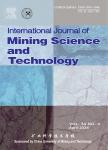Numerical investigation into pillar failure induced by time-dependent skin degradation
Numerical investigation into pillar failure induced by time-dependent skin degradation作者机构:Department of Mining and Materials Engineering McGill University Montreal H3A0E8 Canada
出 版 物:《International Journal of Mining Science and Technology》 (矿业科学技术学报(英文版))
年 卷 期:2017年第27卷第4期
页 面:591-597页
核心收录:
学科分类:081901[工学-采矿工程] 0819[工学-矿业工程] 08[工学]
基 金:financially supported by the Natural Science and Engineering Research Council of Canada (NSERC) in partnership with Vale Ltd–Sudbury Operations Canada under the Collaborative Research and Development Program
主 题:Pillar stability Underground mine Skin degradation Rheological model Time-dependent failure
摘 要:This paper focuses on the instability mechanism of an isolated pillar, caused by time-dependent skin degradation and strength heterogeneity. The time-dependent skin degradation is simulated with a non-linear rheological model capable of simulating tertiary creep, whereby two different pillar failure cases are investigated. The first case is of an isolated pillar in a deep hard rock underground mine and subjected to high stresses. The results show that pillar degradation is limited to the regions near the surface or the skin until two months after ore extraction. Afterwards degradation starts to extend deeper into the pillar, eventually leaving a highly-stressed pillar core due to stress transfer from the failed *** potential indices show that the risk increases exponentially at the core as time goes by. It is then demonstrated that the progressive skin degradation cannot be simulated with conventional strain-softening model assuming brittle failure. The parametric study with respect to the degree of heterogeneity reveals that heterogeneity is key to the occurrence of progressive skin degradation. The second case investigated in this study is pillar failure taking place in a very long period. Such failure becomes significantly important when assessing the risk for ground subsidence caused by pillar collapse in an abandoned mine. The analysis results demonstrate that the employed non-linear rheological model can simulate gradual skin degradation taking place over several hundred years. The percentage of damage zone volume within the pillar is merely 1% after a lapse of one days and increases to 50% after one hundred years, indicating a high risk for pillar collapse in the long term. The vertical displacements within the pillar also indicate the risk of subsidence. The proposed method is suitable for evaluating the risk of ground surface subsidence above an abandoned mine.



